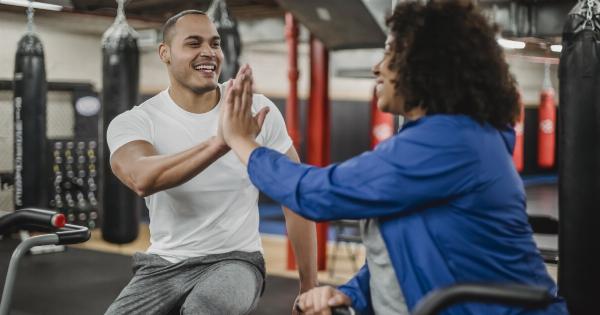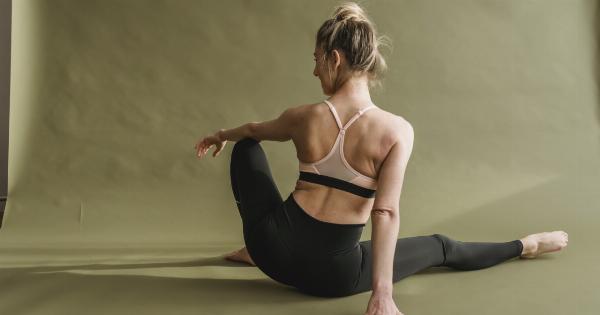When it comes to building a strong and well-defined back, incorporating the right exercises into your workout routine is key.
While there are numerous exercises that target different muscle groups in the back, some exercises stand out for their ability to engage multiple muscles simultaneously and provide maximum results. In this article, we will discuss two super exercises that can take your back workout to the next level.
Exercise 1: Deadlift
The deadlift is often referred to as the king of all exercises, and for good reason. It is a compound movement that primarily targets the muscles in your lower back, but also engages your glutes, hamstrings, and core muscles.
Deadlifts are excellent for building overall back strength, improving posture, and increasing your overall power.
To perform a deadlift:.
- Stand with your feet hip-width apart, toes pointed slightly outward.
- Place the barbell in front of you, with your shins touching the barbell.
- Bend down and grip the barbell with an overhand grip, hands shoulder-width apart.
- Keep your back neutral, chest up, and core engaged as you lift the barbell up by extending your hips and knees.
- As you stand up, squeeze your glutes and keep your shoulders pulled back.
- Lower the barbell back down to the starting position by bending your hips and knees.
Make sure to start with a weight that is challenging but manageable, and gradually increase the weight as you become comfortable with the movement. Proper form is crucial in order to prevent injuries and maximize the benefits of deadlifts.
Exercise 2: Pull-Up
Pull-ups are another fantastic exercise for targeting the back muscles, specifically the latissimus dorsi (lats) and the rhomboids. It is a powerful compound movement that also engages the biceps, shoulders, and core muscles.
To perform a pull-up:.
- Find a pull-up bar or use a sturdy overhead beam.
- Stand beneath the bar and reach up to grip it with your palms facing away from you, hands slightly wider than shoulder-width apart.
- Hang from the bar with your arms fully extended.
- Engage your back muscles and pull your chest towards the bar by bending your elbows.
- Continue the movement until your chin is above the bar.
- Lower yourself back down with control, fully extending your arms.
If you’re new to pull-ups, you can start by performing assisted pull-ups using a resistance band or a pull-up machine. As you gain strength, gradually decrease the assistance until you can perform a full pull-up unassisted.
Benefits of Incorporating These Exercises
Including deadlifts and pull-ups in your back workout routine offers a multitude of benefits:.
1. Muscle Activation
Both deadlifts and pull-ups engage multiple muscle groups simultaneously, ensuring that your entire back is worked effectively. This can lead to better muscle development and overall strength.
2. Posture Improvement
Weak back muscles can contribute to poor posture and increased risk of back pain. Deadlifts and pull-ups strengthen the back muscles, helping to improve your posture and reduce back discomfort.
3. Functional Strength
Deadlifts and pull-ups are compound movements that mimic real-life activities, such as lifting heavy objects or pulling yourself up.
By incorporating these exercises into your routine, you develop functional strength that can translate to improved performance in daily activities.
4. Core Engagement
Both exercises require significant core activation to maintain proper form and stability throughout the movements. Strengthening your core muscles can enhance overall athleticism and provide a solid foundation for other exercises.
5. Time Efficiency
Deadlifts and pull-ups are compound exercises that engage multiple muscles in a single movement. By including these exercises in your routine, you can save time while still targeting several muscle groups in your back.
Tips for an Effective Back Workout
Here are some additional tips to ensure an effective back workout:.
1. Warm-up
Before starting your back workout, it’s essential to warm up your muscles to prevent injuries. Incorporate dynamic stretches, such as arm circles or torso rotations, to increase blood flow to the muscles.
2. Proper Form
Pay close attention to your form during each exercise. Incorrect form can lead to injuries and limit the effectiveness of the movement. If you’re unsure about the proper technique, consider seeking guidance from a qualified fitness professional.
3. Progressive Overload
To continue making progress and challenging your muscles, gradually increase the weight or resistance as your strength improves. Aim to push yourself without sacrificing proper form.
4. Rest and Recovery
Allow your back muscles adequate time to rest and recover between workouts. This allows for muscle growth and helps prevent overuse injuries.
Consider incorporating rest days into your routine or alternating between different muscle groups on consecutive days.
5. Mix Up Your Routine
Vary your exercises regularly to prevent plateaus and keep your workouts exciting. Try different variations of deadlifts and pull-ups, such as sumo deadlifts or wide-grip pull-ups, to target different areas of your back.
Conclusion
Incorporating the deadlift and pull-up into your back workout routine can lead to significant improvements in strength, muscle development, and overall posture.
These two super exercises effectively target various muscle groups in the back and provide numerous benefits. Remember to prioritize proper form, gradually increase the intensity of your workouts, and allow for ample rest and recovery.
With consistency and dedication, your back will become stronger, more defined, and better equipped to support you in daily activities.




























